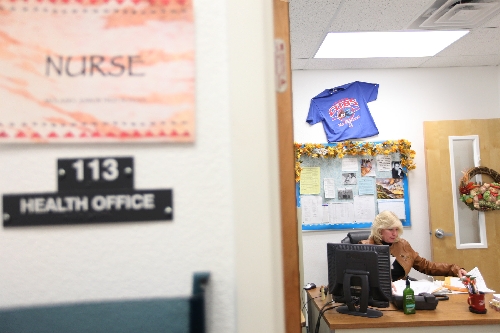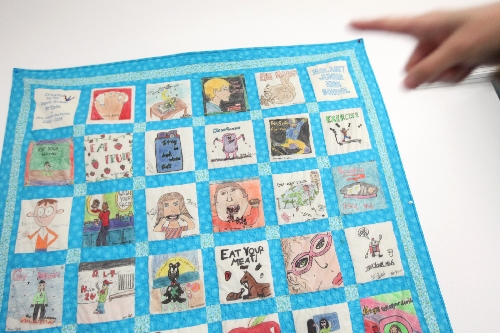Modern school nurses administer medicine, advice and hugs




Las Vegas Day School parent Barbara Gaughan was scared and nervous. Her son, John, was diagnosed with Type 1 diabetes when he was 6 years old, and needed shots all day long. Not an easy proposition for a kid at school.
Easing her worries was registered nurse Kathleen Pathi, whose history at the school stretches back 23 years, first as a parent and then a nurse. For Gaughan and her son, now 12, that long-standing relationship has made a difference.
“When Nurse Pathi came in, she was so knowledgeable and so caring, instantly my son bonded with her,” Gaughan remembered. “I could drop my son off at school with the pure peace of mind that he was safe.”
When her son was hospitalized and near death, Gaughan didn’t call the school. But Pathi noticed his absence from a day of football camp and made some inquiries. On her own, she joined Gaughan at the hospital.
“She stayed with me for hours and hours and never left my side,” Gaughan said.
Pathi made the time, although she oversees close to 900 students at the school, whisking from one of three buildings to the next. With help from aides in each building, she juggles health education, routine diabetes visits, medication administration and kids seeking hugs.
School nurses across the valley are juggling more than Band-Aids, these days. They’re child advocates, conducting screenings for issues such as hearing and vision to ensure that kids can succeed in school – and going after that pair of glasses for the kid whose family can’t afford it. Or they’re coordinating one of Clark County School District’s many special clinics to identify and assist with major health conditions not covered by a family’s insurance.
Add to that a long list of other duties, including but not limited to: teaching kids about the perils of Monster energy drinks and Starbucks; educating teachers about the rising tide of allergies, anaphylactic reactions and epinephrine use; taking on the issue of domestic minor sex trafficking; serving as a liaison with pediatric endocrinologists; collaborating with doctors and foundations; spotting illnesses that doctors sometimes miss; and even disaster planning.
Then try doing some of that while telling one kid to lie down and another what not to touch in the nurse’s office – all while overseeing an average of 1,850 students, if you’re a school nurse in the Clark County School District.
“It’s busier than when I was in schools,” said Diana Taylor, the district’s director of health services and a former school nurse herself.
The school district hasn’t lost any nursing staff based on budget issues, she said. But she has noticed, in the past decade, an increase in the number of medically fragile students, including kids with tracheostomies and portable ventilators.
Possible reasons for the increase: improved medical technology, as well as the recognition that children can benefit from socializing with their peers at school.
“We no longer hide children that have handicaps at home in the closet, or at special schools,” agreed Carol Dahn, nursing lecturer at Nevada State College, adding “Most people don’t understand what it takes to be a school nurse.”
After serving in Operation Desert Storm and retiring from a career as an Army nurse, Dahn served as a school nurse in rural New Mexico. Then she moved on to school nursing duties in the Clark County School District, from 1997 to 2006. She now oversees a required eight-week course at the college that gives nursing students the option to do a rotation in the Clark County School District. So far, Dahn said, five or six nursing students have gone on to become school nurses.
One act of advocacy that she cites from her own school nursing career is the time she had to get nursing administration involved when a site administrator tried to put a child with diabetes outside in a portable building with no running water and no bathroom – where he could have passed out, anytime.
With asthma, allergies and mental health issues increasing among kids, school nurses have still other issues to juggle, along with the usual pinkeye and sore throats. Whether that’s because of worsening air quality or a wave of nonimmunizations, many nurses agree that they just never know what’s coming next.
Registered nurse Ann Liles, a school nurse in the Clark County School District, said she likes the mystery solving part of the job.
“I’m given a picture by six teachers,” she explained. “And what we get is often more than what the doctor gets.”
But there was a time many years ago when, as a nurse doing home care, she picked up her son from the seventh grade and encountered his school nurse.
“I said, ‘Don’t you just check lice?’ ” she recalled.
Liles went on to a school nursing career that encompasses everything from suicide prevention education to blood-pressure checks for staff. And she has her master’s degree in teaching.
Dahn said school nurses in Clark County jump through a daunting array of hoops when it comes to education and experience. School nurses endure fingerprinting, must acquire solid general medical-surgical experience and must meet the requirements that keep both their nursing and educator’s licenses current.
School nurses must also pass exams on educational law, the U.S. Constitution and the Nevada Constitution.
Clark County School District nurses all come with experience.
“All of our nurses come to us from having positions in other nursing environments,” Taylor said. “We don’t have any new grads. Everybody who comes to us has been a registered nurse somewhere else.”
She added that some nursing job applicants have withdrawn when they found out what the job entailed.
Nurses in the school district try to conquer the workload with a team approach, assisting one another. They’re also usually assigned to two to three schools, Taylor said, perhaps spending two days a week at a school, with support from specially trained first aid safety assistants. The system has changed over the years, she said.
“I think it’s probably more efficient, partly because we’ve had to be,” she said.
Not everyone agrees. Nikki Clark, whose mother is a school nurse in Reading, Pa., remembered being at work as a server at the Hard Rock Cafe last year, in the throes of the Labor Day weekend and being slammed with orders. That’s when she received seven phone calls from what she believed was a paraprofessional at her 15-year-old daughter’s school. Her daughter had a piece of dirt in her eye.
“I told them, ‘If this is an emergency, take her to St. Rose and I’ll meet you there,’ ” she said. “ ’Well, no, it’s not like that.’ Then stop calling me! My boss got on the phone and talked to them.”
When Clark left work and arrived at school, her daughter was in gym class. And, one of the paraprofessionals in the nurse’s office asked her for a job at the Hard Rock.
“The first aid safety assistant, the paraprofessional, is only as good as the site administrator will allow them to be,” Dahn said. “Many times inappropriate people are chosen in the process.”
Carl Miller, another nurse in the Clark County School District – and a former New Mexico school principal as well as an educator – has yet another take, based on his years of watching departments pull together, or not pull together.
“We look at issues that need to be resolved. They get resolved,” he said. “This city is so lucky, to have the corps of people that we do. It works right.”
Nevertheless, with all that’s required of them, nurses in the Clark County School District lose out on the overtime pay that’s available in a hospital, Taylor said. Their compensation remains on the teachers’ pay scale. But the payback includes a positive, kid-friendly environment, and a desirable schedule that often matches their own children’s school calendar, without the 12-hour shifts that come with nursing territory elsewhere.
Some schools question the need to pay a school nurse at all. Deborah Ingalls, elementary principal at Green Valley Christian School, said that her school consists of about 315 students. It doesn’t employ a school nurse. Instead, all staff have CPR and first-aid training, and every classroom comes with a master teacher and a teacher assistant. The school employs a protocol that requires the teacher assistant to perform tasks such as escorting sick students to the office and taking their temperature.
Other staff members also take on responsibilities such as overseeing students who give themselves insulin, and staying in contact with the Nevada Department of Health.
Whether schools with a nurse have an advantage over her own school’s approach, Ingalls said, “it’s a half-dozen of one. We know every kid. I know them by name. I know their parents’ names. I know how long they’ve been on medication. I know who my kids are. That goes a long way.”
But working in a larger system does offer rewards for those with a long-term community vision.
“I get to fight for kids that have needs,” Miller said.












